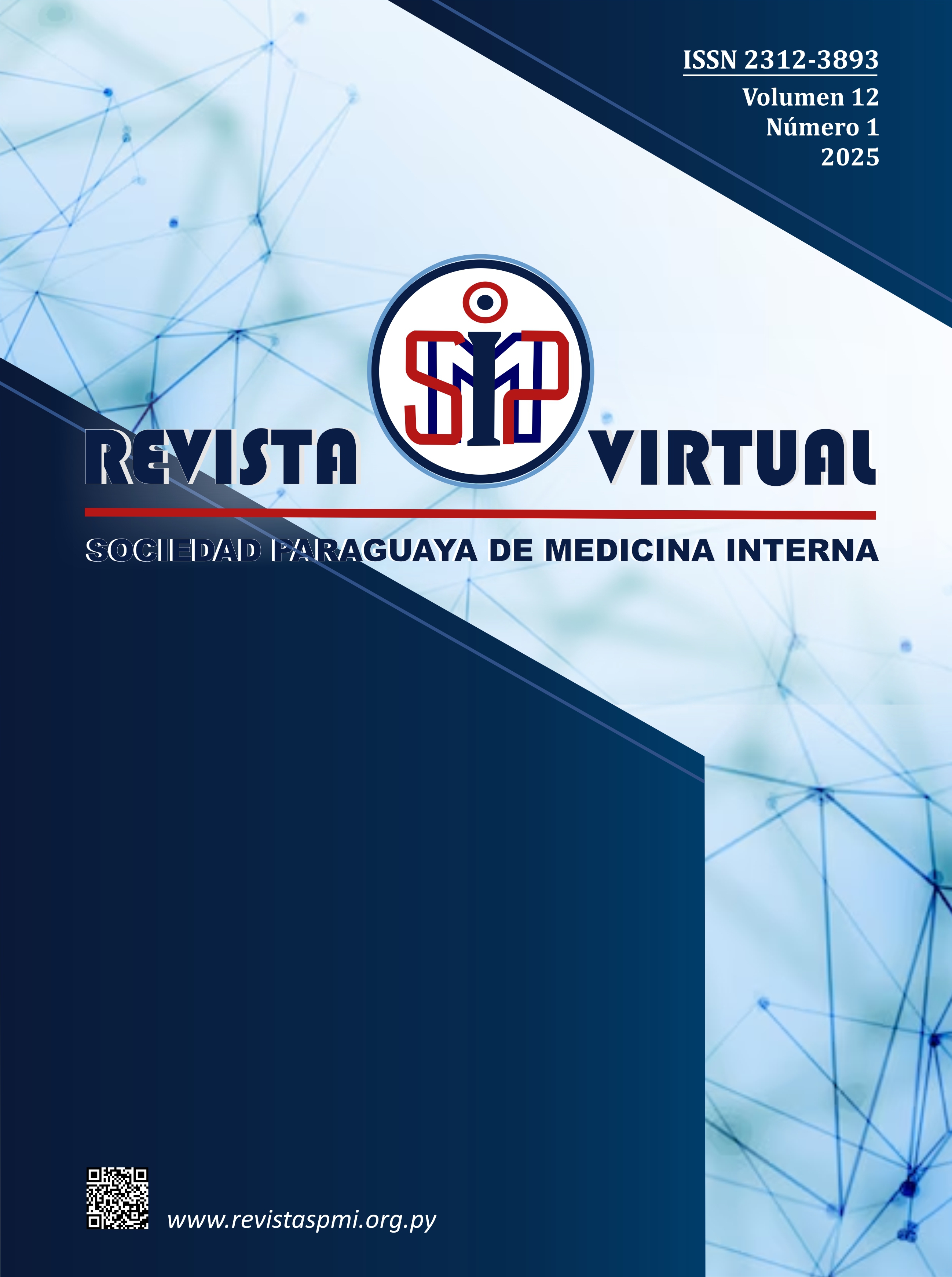Diferencias de sexo en la evolución y tratamiento de la fibrilación auricular no valvular
Resumen
Introducción: la fibrilación auricular no valvular (FANV) es la arritmia cardíaca más común en la práctica clínica. Se ha visto que la presentación clínica y el tratamiento de esta arritmia varía según el sexo.
Objetivo: determinar las diferencias de sexo en la evolución clínica y la respuesta al tratamiento antitrombótico en pacientes internados con diagnóstico de FANV.
Metodología: se realizó un estudio observacional analítico, retrospectivo, de corte transversal en pacientes internados con FANV en el Hospital Nacional de Itauguá, Paraguay, durante el 2024. Los datos se extrajeron de las fichas clínicas completas que contenían estas variables: edad, sexo, tipo de tratamiento antitrombótico recibido, y puntuaciones de riesgo tromboembólico (CHA₂DS₂-VASc) y de sangrado (HAS-BLED).
Resultados: se incluyeron 371 casos, el 61,5% era del sexo femenino. En el 38,2% de las mujeres y en el 35% de los hombres se utilizaron anticoagulantes orales directos, el 36,6% de los pacientes se fue de alta sin reincidencias y el 39,8% de los hombres tuvo una reincidencia de FANV
Conclusión: no se observaron diferencias entre hombres y mujeres en la evolución clínica y la respuesta al tratamiento antitrombótico en pacientes con FANV, lo que resalta la importancia de incorporar el enfoque de género en su abordaje terapéutico.
Citas
2. Kornej J, Börschel ChS, Benjamin EJ, Schnabel RB. Epidemiology of atrial fibrillation in the 21st century: Novel methods and new insights. Circ Res [Internet] 2020 [cited 2024 Oct 7];127(1):4–20. Available from: https://pubmed.ncbi.nlm.nih.gov/32716709/
3. Lip G, Freedman B, De Caterina R, Potpara TS. Stroke prevention in atrial fibrillation: Past, present and future. Comparing the guidelines and practical decision-making. Thromb Haemost [Internet] 2017 [cited 2024 Oct 7];117(7):1230–9. Available from: https://pubmed.ncbi.nlm.nih.gov/28597905/ Subscription required
4. Chugh SS, Havmoeller R, Narayanan K, Singh D, Rienstra M, Benjamin EJ, et al. Worldwide epidemiology of atrial fibrillation: a Global Burden of Disease 2010 Study. Circulation [Internet] 2014 [cited 2024 Oct 7];129(8):837–47. Available from: https://pubmed.ncbi.nlm.nih.gov/24345399/
5. González-Hermosillo JA, Baños-González MA, Guevara-Valdivia ME, Vázquez-Acosta JA, Odín de Los Ríos Ibarra M, Aguilar-Linares KA, et al. Gender differences and management of stroke risk of nonvalvular atrial fibrillation in an upper middle-income country: Insights from the CARMEN-AF registry. Int J Cardiol Heart Vasc [Internet]. 2019. [cited 2024 Oct 7]; 22: 117-22. Available from: https://pubmed.ncbi.nlm.nih.gov/30705937/
6. Go AS, Hylek EM, Phillips KA, Chang Y, Henault LE, Selby JV, Singer DE. Prevalence of diagnosed atrial fibrillation in adults: national implications for rhythm management and stroke prevention: the AnTicoagulation and Risk Factors in Atrial Fibrillation (ATRIA) Study. JAMA [Internet] 2001 [cited 2024 Oct 7];285(18):2370–5. Available from: http://dx.doi.org/10.1001/jama.285.18.2370
7. Wilson RE, Rush KL, Reid RC, Laberge CG. Gender and the Symptom Experience before an atrial fibrillation diagnosis. West J Nurs Res [Internet] 2021 [cited 2024 Oct 7];43(12):1093–104. Available from: http://dx.doi.org/10.1177/0193945921999448
8. January CT, Wann LS, Calkins H, Chen LY, Cigarroa JE, Cleveland JC Jr, et al. 2019 AHA/ACC/HRS focused update of the 2014 AHA/ACC/HRS guideline for the management of patients with atrial fibrillation: A report of the American College of Cardiology/American Heart Association task force on clinical practice guidelines and the Heart Rhythm Society in collaboration with the Society of Thoracic Surgeons. Circulation [Internet]. 2019 [cited 2024 Oct 7];140(2): e125-e151. Available from: http://dx.doi.org/10.1161/cir.0000000000000665
9. Rago A, Pirozzi C, D’Andrea A, Di Micco P, Papa AA, D’Onofrio A, et al. Gender differences in atrial fibrillation: From the thromboembolic risk to the anticoagulant treatment response. Medicina (Kaunas) [Internet]. 2023 [cited 2024 Oct 7];59(2):254. Available from: http://dx.doi.org/10.3390/medicina59020254
10. Islam S, Dover DC, Daniele P, Hawkins NM, Humphries KH, Kaul P, et al. Sex differences in the management of oral anticoagulation and outcomes for emergency department presentation of incident atrial fibrillation. Ann Emerg Med [Internet] 2022 [cited 2024 Oct 7];80(2):97–107. Available from: https://pubmed.ncbi.nlm.nih.gov/35469679/
11. Rathfoot C, Edrissi C, Sanders CB, Knisely K, Poupore N, Nathaniel T. Gender differences in comorbidities and risk factors in ischemic stroke patients with a history of atrial fibrillation. BMC Neurol [Internet] 2021 [cited 2024 Oct 7];21(1):209. Available from: http://dx.doi.org/10.1186/s12883-021-02214-8
12. Westerman S, Wenger N. Gender differences in atrial fibrillation: A review of epidemiology, management, and outcomes. Curr Cardiol Rev [Internet] 2019 [cited 2024 Oct 7];15(2):136–44. Available from: https://pubmed.ncbi.nlm.nih.gov/30516110/
13. Noubiap JJ, Thomas G, Nyaga UF, Fitzgerald JL, Gallagher C, Middeldorp ME, Sanders P. Sex disparities in enrollment and reporting of outcomes by sex in contemporary clinical trials of atrial fibrillation. J Cardiovasc Electrophysiol. 2022 May;33(5):845-854. doi: 10.1111/jce.15421. Available from: https://pubmed.ncbi.nlm.nih.gov/35178812/
14. Mantilla-Villabona LY, Ospina-Galeano DC, Gutiérrez-Ortiz AJ, Camacho PA. Pacientes con fibrilación auricular atendidos en consulta de atención primaria de una institución de alta complejidad . Rev Colomb Cardiol [Internet] . 2018;25(2):124-130. Disponible en:https://www.elsevier.es/es-revista-revista-colombiana-cardiologia-203-articulo-pacientes-con-fibrilacion-auricular-atendidos-S0120563317302097
15. Kassim NA, Althouse AD, Qin D, Leef G, Saba S. Gender differences in management and clinical outcomes of atrial fibrillation patients. J Cardiol [Internet] 2017 [cited 2024 Oct 7];69(1):195–200. Available from: https://pubmed.ncbi.nlm.nih.gov/27262176/
16. García-Martínez D, Osuna-Sánchez J, Pérez-Belmonte LM, de Teresa-Galván E. Enfermedad cardiovascular y nivel educacional en España, periodo 2005-2014: análisis por comunidades/ciudades autónomas [Carta científica]. REC CardioClinics [Internet]. 2019 [citado 7 Oct 2024]; 54(1): 53-5. Disponible en: https://www.reccardioclinics.org/es-enfermedad-cardiovascular-nivel-educacional-espana-articulo-S2605153219300111
17. Durán-Bobín O, Elices-Teja J, González-Melchor L, Vázquez-Caamaño M, Fernández-Obanza E, Eva González-Babarro E, et al. Differences in the clinical profile and management of atrial fibrillation according to gender. Results of the Registro Gallego Intercéntrico de Fibrilación Auricular (REGUEIFA) trial. J Clin Med [Internet]. 2021 [cited 2024 Oct 7]; 10(17): 3846. Available from: https://www.mdpi.com/2077-0383/10/17/3846
18. Castro-Clavijo JA, Quinterob S, Valderramab F, Diaztaglec JJ, Ortegad J. Prevalencia de brilación auricular en pacientes hospitalizados por Medicina interna. Rev. colomb. cardiología [Internet]. 2020 [citado 7 Oct 2024]; 27(6): 557-63. Disponible en: https://www.elsevier.es/es-revista-revista-colombiana-cardiologia-203-articulo-prevalencia-fibrilacion-auricular-pacientes-hospitalizados-S0120563319301044
19. Barrios V, Escobar C, Lobos JM, Polo J, Vargas D. Uso de los anticoagulantes orales de acción directa en atención primaria: Estudio ACTUA. Semergen [Internet]. 2017 [citado 7 Oct 2024]; 43(7):477–85. Disponible en: https://www.sciencedirect.com/science/article/abs/pii/S1138359316302155?via%3Dihub
20. Pérez-Copete J, Esteve-Pastor MA, Roldán V, Valdés M, Marín F. Escalas de evaluación del riesgo tromboembólico y hemorrágico en la fibrilación auricular. Rev Esp Cardiol [Internet]. 2016 [citado 7 Oct 2024]; 16 [Supl. A]:25–32. Disponible en: https://www.revespcardiol.org/es-escalas-evaluacion-del-riesgo-tromboembolico-articulo-S1131358716300115
21. Shiyovich A, Chodick G, Azani L, Tirosh M, Shuvy M, Pereg D, Katz A, Minha S. Sex-specific contemporary trends in incidence, prevalence and survival of patients with non-valvular atrial fibrillation: A long-term real-world data analysis. PLoS One. 2021 Feb 18;16(2):e0247097. doi: 10.1371/journal.pone.0247097. Available from: https://pubmed.ncbi.nlm.nih.gov/33600504/
22. Ko D, Rahman F, Schnabel RB, Yin X, Benjamin EJ, Christophersen IE. Atrial fibrillation in women: epidemiology, pathophysiology, presentation, and prognosis. Nat Rev Cardiol [Internet]. 2016 [cited 2024 Oct 7];13(6):321–32. Available from: https://pubmed.ncbi.nlm.nih.gov/27053455/
23. Granger CB, Alexander JH, McMurray JJV, Lopes RD, Hylek EM, Hanna M, et al. Apixaban versus warfarin in patients with atrial fibrillation. N Engl J Med [Internet]. 2011 [cited 2024 Oct 7];365(11):981–92. Available from: http://dx.doi.org/10.1056/NEJMoa1107039
24. Ohlrogge AH, Schnabel RB. Atrial fibrillation in women. En: Maas AH, Gerdts E, Eds. Manual of cardiovascular disease in women. Cham: Springer; 2024. p. 297–314
25. Khaing E, Aroudaky A, Dircks D, Almerstani M, Alziadin N, Frankel S, et al. Representation of Women in Atrial Fibrillation Ablation Randomized Controlled Trials: Systematic Review. J Am Heart Assoc. 2025 Jan 21;14(2):e035181. doi: 10.1161/JAHA.124.035181. Available from: https://pubmed.ncbi.nlm.nih.gov/39791402/
26. Potpara TS, Blomstrom-Lundqvist C. Sex-related differences in atrial fibrillation: can we discern true disparities from biases? Heart. 2017 Jul;103(13):979-981. doi: 10.1136/heartjnl-2016-311085. Available from: https://pubmed.ncbi.nlm.nih.gov/28456754/
27. Steinberg BA, Shrader P, Pieper K, Thomas L, Allen LA, Ansell J, et al. Frequency and outcomes of reduced dose non-vitamin K antagonist anticoagulants: Results from ORBIT-AF II (The Outcomes Registry for Better Informed Treatment of Atrial Fibrillation II). J Am Heart Assoc [Internet]. 2018 [cited 2024 Oct 7];7(4): e007633. Available from: https://pubmed.ncbi.nlm.nih.gov/29453305/
28. Liao JN, Huang YS, Tsai CT, Kuo L, Chen SJ, Tuan TC, et al. Gender differences in patients with atrial fibrillation receiving oral anticoagulants. Rev Cardiovasc Med [Internet] 2024 [cited 2024 Oct 7];25(3):92. Available from: http://dx.doi.org/10.31083/j.rcm2503092

















